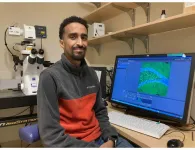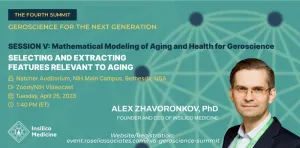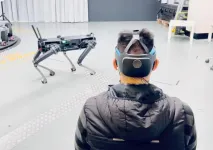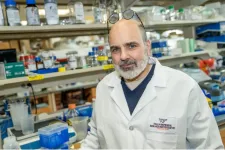(Press-News.org)
New research at the University of Massachusetts Amherst zeroes in on the root cause of adverse health effects from disruption of the body’s circadian rhythms, which typically occurs from jet lag and rotating work shifts.
The research, published in the journal eNeuro, also shows that the circadian clock gene Cryptochrome 1 (Cry 1) regulates adult neurogenesis – the ongoing formation of neurons in the brain’s hippocampus. Adult neurogenesis supports learning and memory, and its disruption has been linked to dementia and mental illness.
“Circadian disruption impacts a lot of things,” says lead author Michael Seifu Bahiru, a Ph.D. candidate in the lab of Eric Bittman, Professor Emeritus of Biology. “There are links to cancer, diabetes and hypertension, as well as adverse impacts on neurogenesis.”
Cell birth and survival in the adult hippocampus are regulated by a circadian clock, so its disruption may throw off the process of neurogenesis. In the U.S. alone, some 30 million people experience phase shifts in their circadian rhythms as they work rotating schedules.
Until recently, the researchers have faced a sort of chicken-or-egg question. “We always wondered what actually is the root cause of the ailments from circadian disruption?” Bahiru says. “Does the problem come from the act of shifting or the shift itself?”
Bittman explains further, “It’s possible it’s just changing the light cycle that affects neurogenesis, that jerking your clock around is bad for you, as opposed to the jet lag, which is the time delay that it takes for all circadian-dependent systems in your body to adjust to this change in daylight.”
Their findings support the hypothesis that it’s this internal misalignment, this state of desynchrony between and within organs that occurs during jet lag, that is responsible for the adverse impact on neurogenesis – and, they suspect, other adverse health effects from circadian disruption.
To test their hypothesis, they studied cell birth and differentiation in Syrian hamsters with a recessive mutation in the Cry 1 gene that speeds up the clock in constant conditions and dramatically accelerates its ability to shift in response to light. Bittman named the mutation, discovered in previous research, duper. The research team also tested a control group of hamsters without the duper mutation. Both underwent the same sequence of changes in the light cycle.
They simulated jet lag in the form of eight-hour advances and delays at eight 16-day intervals. A cell birth marker was given in the middle of the experiment. Results showed that jet lag has little effect on cell birth but steers the fate of newborn cells away from becoming neurons. Dupers are immune to this effect of phase shifts. “As predicted, the duper animals re-entrained quicker, but also were resistant to the negative effects of the jet lag protocol, whereas the control – the wild type hamsters – had reduced neurogenesis,” Bahiju says.
“The findings indicate that circadian misalignment is critical in jet lag,” the paper concludes.
The ultimate goal of Bittman’s lab is to advance understanding of the pathways involved in human biological clocks, which could lead to the prevention of or treatment for the effects of jet lag, shift work and circadian rhythm disorders. This latest research is a next step toward that goal.
Now the team will turn to “a big unanswered question,” Bittman says – “whether it’s the operation of circadian clocks in the hippocampus that is being directly regulated by shifts of the light:dark cycle, or whether neurogenesis is controlled by biological clocks running in cells elsewhere in the body.”
Another possibility, which Bittman thinks is more likely, is that the master pacemaker in the suprachiasmatic nucleus of the hypothalamus in the brain detects the light shift and then relays it to the stem cell population that has to divide and differentiate in the hippocampus.
END
Insilico Medicine founder and CEO Alex Zhavoronkov, PhD, a pioneer in generative AI for drug discovery and in uncovering dual pathways for aging and disease, will present at The Fourth Summit: Geroscience for the Next Generation organized by the Geroscience Interest Group of the National Institutes of Health (NIH) and the U.S. Department of Health and Human Services, happening April 24-26 at the NIH Main Campus in Bethesda, Maryland. Zhavoronkov will speak April 25, 1:40pm ET as part of the session on Mathematical Modeling of Aging and Health for Geroscience on “Selecting and Extracting Features Relevant to ...
It sounds like something from science fiction: Don a specialized, electronic headband and control a robot using your mind. But now, recent research published in ACS Applied Nano Materials has taken a step toward making this a reality. By designing a special, 3D-patterned structure that doesn’t rely on sticky conductive gels, the team has created “dry” sensors that can measure the brain’s electrical activity, even amidst hair and the bumps and curves of the head.
Physicians monitor electrical signals ...
Older adults perceive artificial intelligence as more human-like than younger adults do
Toronto, April 3, 2023 – Artificial intelligence (AI) is increasingly present in all of our lives, from newer offerings like ChatGPT to more established voice systems such as automated phone services, self-checkouts, Apple’s Siri and Amazon’s Alexa. While these technologies largely benefit us, they can also be used in adverse ways – for instance, in fraudulent or scam calls – making it important for us to be able to identify them.
According to a recent Baycrest study, older adults appear to be less able to distinguish ...
SPOKANE, Wash. – An online “e-health” program helped more people with chronic pain reduce their opioid medications and pain intensity than a control group that had only regular treatment in a recent clinical study.
In the study published in the journal Pain, about 400 participants who had been prescribed long-term opioid treatment for their pain were divided into two groups: one received treatment as usual and another received treatment and access to a self-guided, e-health program. Of the e-health group, more than half, 53.6%, were able to reduce their ...
Researchers have succeeded for the first time in adding a highly purified form of curcumin to yogurt in a way that ensures it remains dissolved in the dairy product and preserves it, while tasting good.
Their discovery, which is published today (Monday) in Frontiers in Nutrition, makes it possible to create a probiotic yogurt that contains no artificial preservatives but that still has a long shelf life and properties that may enhance good health.
Curcumin is a naturally-occurring chemical that provides the yellow colour in turmeric. Studies have shown that it has anti-inflammatory and anti-oxidative properties, that it can inhibit the growth ...
A linguistic bias in the English language that leads us to ‘improve’ things by adding to them, rather than taking away, is so common that it is even ingrained in AI chatbots, a new study reveals.
Language related to the concept of ‘improvement’ is more closely aligned with addition, rather than subtraction. This can lead us to make decisions which can overcomplicate things we are trying to make better.
The study is published today (Monday 3rd April) in Cognitive Science, by an international ...
Government-assisted refugees were less likely to receive adequate prenatal care than privately sponsored refugees, found a new study published in CMAJ (Canadian Medical Association Journal) https://www.cmaj.ca/lookup/doi/10.1503/cmaj.221207.
Canada has 2 main pathways to resettle refugees: government assistance and private sponsorship by family members or non-family volunteers.
To determine whether refugees receive adequate prenatal care (defined as initiation of prenatal care by 13 weeks' gestation; receipt of a minimum number of prenatal care visits, as recommended by the Society of Obstetricians and Gynaecologists of Canada; and receipt of a prenatal fetal anatomy ultrasound ...
The quality and integrity of peer review in Higher Education research has been put firmly in the spotlight by the European Journal of Higher Education (EJHE), published by Taylor & Francis. All articles submitted from April 2023 will, if accepted, have their reviewer reports published at the same time, as part of a one-year pilot.
The EJHE peer review process itself will remain the same, with reports on manuscripts under consideration received from two or three referees before an editorial decision is made. ...
The human brain begins to assemble itself shortly after conception as a growing number of brain cells connect to create circuits across the brain.
Genes provide the blueprint for construction, but occasionally the blueprint is incomplete, connections aren’t made, and circuits fail — sometimes long before the problem can be recognized, let alone fixed.
That’s the case with DiGeorge syndrome, also called 22q11.2 deletion syndrome, a genetic disorder affecting about one in 3,000 babies. It begins with a deletion of one of two copies of a small number of genes on human chromosome 22, whose cascading effects include cardiovascular problems, craniofacial ...
Polyamorists face stigma and discrimination in their day-to-day lives, yet research shows that having a romantic relationship with more than one person at a time may offer emotional and physical benefits to all parties.
Monogamy is frequently portrayed as the ideal form of romantic love in many modern societies. From the stories we read as children, to the films and books we consume as adults – we are told that to achieve happiness we need to find our one true soulmate to share the rest of our lives with.
At the same time, states and governments offer financial, legal, and social incentives to married couples. Meanwhile men and women who deviate from these monogamous ...



